Impacts of Climate Change
Canadian Context
Climate change impacts are geographically and spatially diverse, and it is important to learn about your place or the Canada-wide context.
Below are some of the negative results of climate change. Click and drag the effects that you think go under each result to see if they match.
If you’re having trouble seeing the entire chart, click the blue full screen button on the top right-hand side of the chart to make the chart bigger.
Changes to the Economy
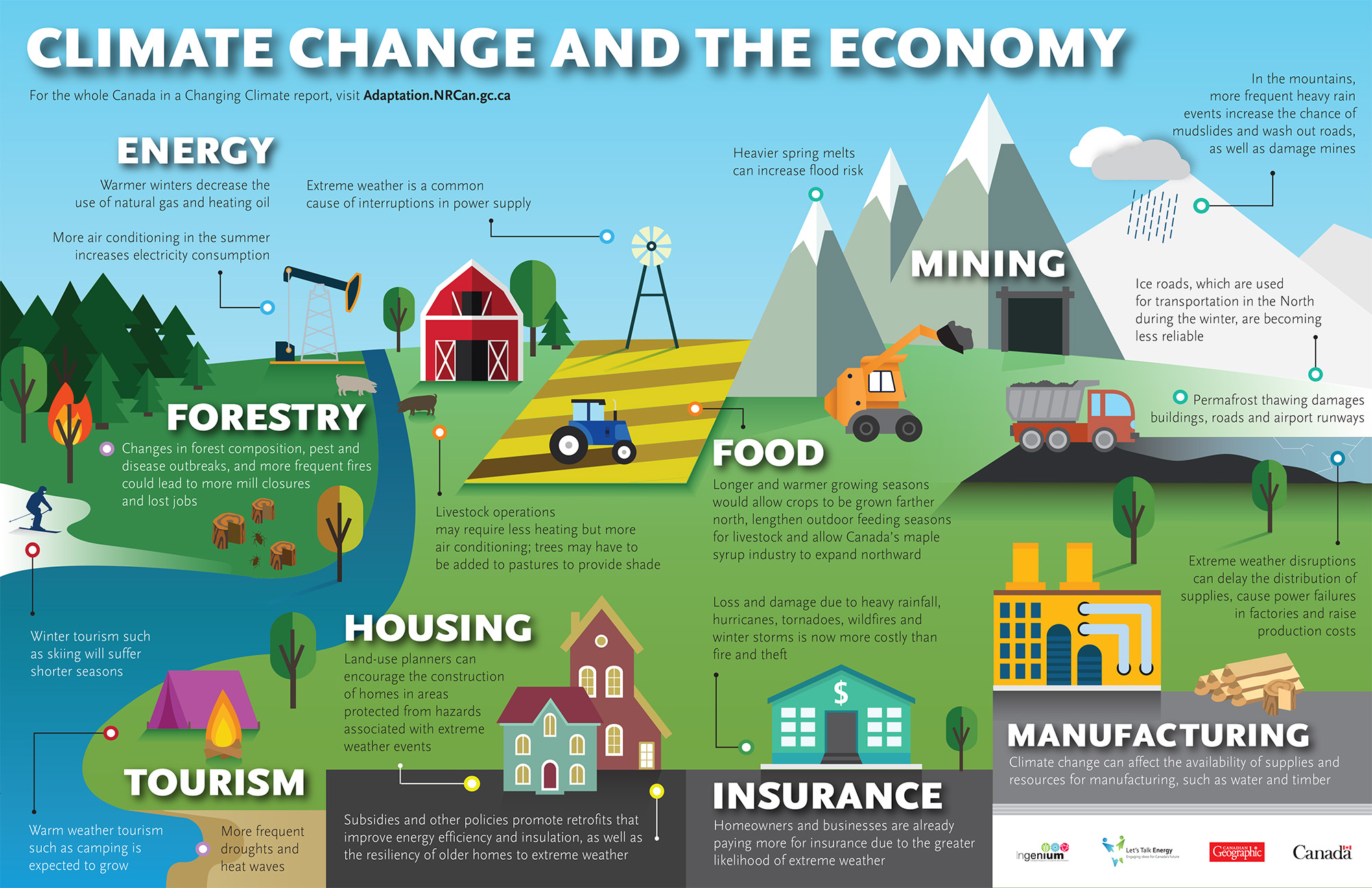
Changes to the Environment
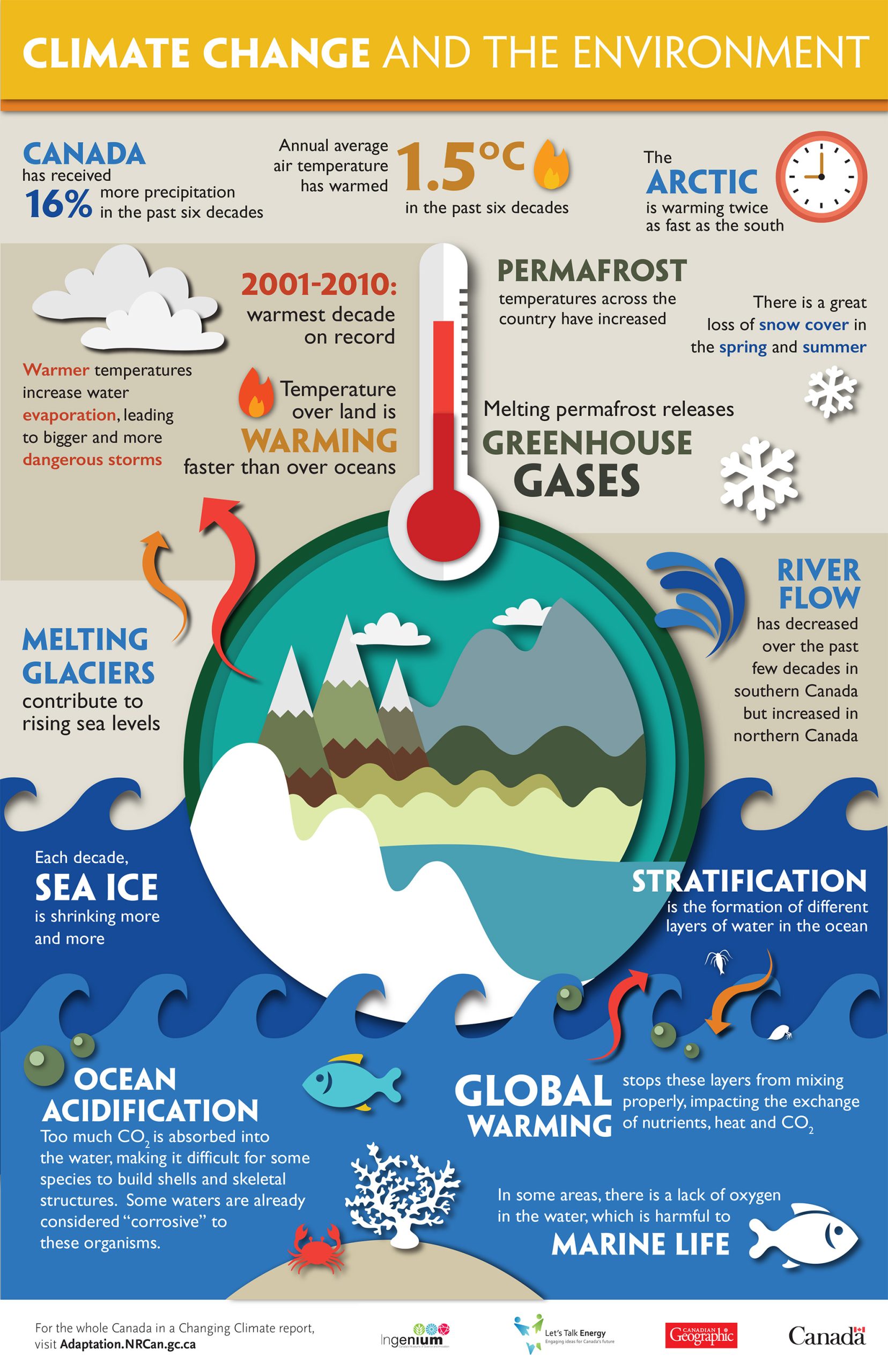
Changes to Biodiversity
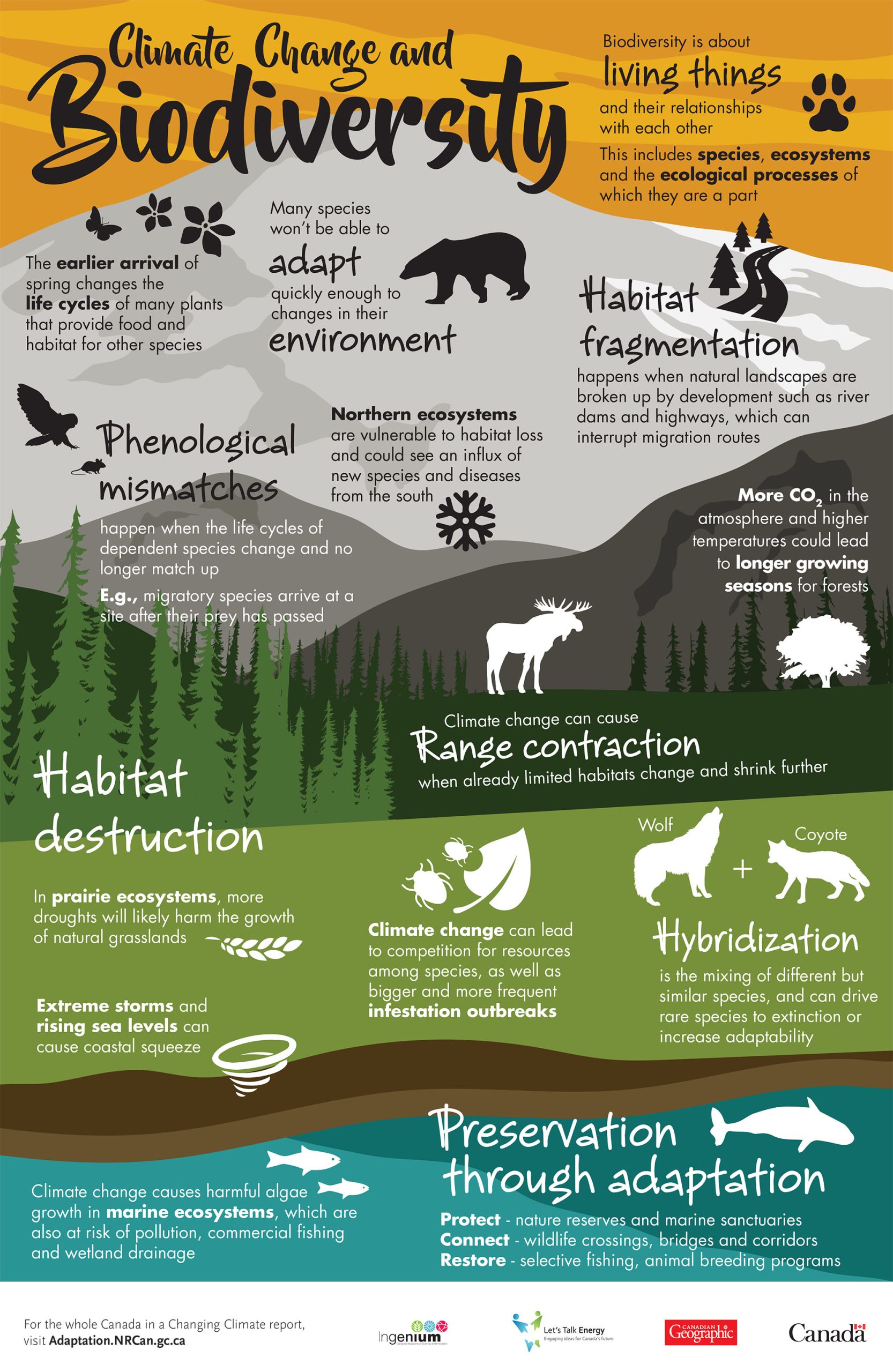
Climate Change Impacts on Outdoor Activities and Recreation
A determining factor in the diversity of outdoor recreation available in Canada is the climate. Climate plays a direct role in defining the length and quality (i.e., overall comfort and enjoyment of outdoor experience) of recreation and tourism seasons and in influencing the level of participation. The spatial diversity of climate change impacts can be seen in the many studies looking at the impacts of climate change on outdoor recreation and tourism.[1]
Briefly summarized, it means increases to warm-weather recreation (e.g., fishing and watersports — as long as the heat doesn’t get so extremely hot or too dry to support the fish or waterbody depth, as is now being seen in many places) and decreases to winter sports like skiing and ice skating (due to with more precipitation as rain rather than snow).
The reality is that climate change isn’t just happening in gradual steps toward an extreme; we see more variability and more extremes that are hard to predict; however, we do expect to see “increases in hot extremes in central and southeastern Canada and increases in wet extremes in western coastal regions.”[2]
Case Study: Canadian Outdoor Recreation Climate ImpactsUsing the map below, click different hotspots throughout Canada to see how climate change is altering the country.
|
|
|
|---|
| ㅤ |
Investigate the map at the Canadian Climate Atlas. Use the toggles to look at different predicted times and levels of climate change.Use the ‘Find Local Data’ option to learn more about your place or the place you will be guiding. You can download graphs and a PDF of information for your place. |
True or False?


Climate Change Adaptation and Mitigation
From all of the above information, we hope to emphasize five key beliefs people need to connect with to be motivated to take action on climate change:
1) Climate change is real
2) Human activities are driving it
3) Experts agree on this
4) The impacts are serious and already happening, and
5) There is hope to make a difference when we act collectively.
Accepting that we, and you, are already experiencing the effects of climate change in our/your community in some way — whether it’s unprecedented heat, precipitation, or wildfire events causing floods, landslides, or decreased air quality — means that now rather than just mitigate or reduce the causes of climate change, we also need to adapt to the effects we already see and build resilience.
|
|
|---|
| ㅤ |
Drag and drop the correct icons into the mitigation and adaptation diagram below, remembering that mitigation is ‘reducing efforts’ and adaptation is ‘modifying the way we do things to adjust to change.’Whether adapting or mitigating, taking action is key. |
Personal Experiences of Climate Change
By now, most people have had an experience with or perception of climate disruption. These experiences and perceptions can come directly through a personal encounter with a climate impact (e.g., flooding event, wildfire, disease proliferation) or indirectly through our relationships with friends, family, communities, places that matter to us, or via the news as well as social and other media.
Our experiences and perceptions can deeply affect how we think of, feel about, and interact with the world around us. Sharing our experiences and perceptions can be a valuable way to process our feelings, connect with others, and lay the foundation for strong relationships, flourishing communities, and the ability to enact change in our guiding or other work communities.
|
|
|---|
| ㅤ |
Where have you seen evidence of climate change in your community or in the field? Note that some effects of climate change exacerbate or enhance some events or cycles that exist naturally (e.g., wildfires).Emotions are powerful. They can stop us in our tracks or spur us on to our greatest achievements. Social-emotional work (that is often a by-product of engaging with people in natural spaces or on trips or events that inspire or challenge them) can be exhausting, but finding a community that can bolster us with social-emotional support can be incredibly empowering.As Du Bray et al. observed, “Charged emotional spaces offer a route for individuals and communities to work together; if [community members]… can find common ground, there may be room for changes that reflect their interests and concerns regarding climate change.”[3] |

“The Seventh Generation philosophy is integral to Haudenosaunee life. It intensifies the bond of community, promotes stability, and provides concrete values with which each person can test his or her everyday actions. Although the Haudenosaunee practise ancient traditions, their culture is not frozen in the past. Their ability to adapt to dramatic change and survive on their own terms is historically proven, but they are equally focused on the security of future generations.”
– Oren Lyons (Seneca) – Faithkeeper, Onondaga Nation

Your Role in Relation to Climate Change
Part of Environmental Leadership is to provide the most up-to-date information on the state, health, and ways that our environment operates. As we see current and anticipate larger changes in our environmental wellbeing, leadership in this field must connect to stewardship, conservation, and consideration at all times in order to support preservation, restoration, and adaptation for our changing climate.
Adopting a widespread Indigenous perspective of ‘7 generation thinking’ is one way to consider the lengths at which we must look back and make changes for the future (acting based on the impact we will have for seven generations) if we are to make a real difference and preserve our way of life for the future enjoyment and wellbeing of others.
While understanding the climate of our planet and the intersection of layers of temporal and spatial scales of forcing mechanisms, climatic inputs, and climate outputs is extremely complex and beyond the scope or needs of most people in their day-to-day work position or life, it can be helpful to know the basics of natural versus anthropogenic climatic cycles and be able to debunk myths or fallacies that people may espouse as they participate in your programs and provide suggestions for how we can adapt, be resilient, and make good choices to mitigate our impacts on the climate and environment.
We ask that you integrate into your work wherever possible…

Sustainability
Incorporate sustainability education into the work you do. This may include sharing topics such as waste reduction, energy conservation, and sustainable transportation with guests. Your participants may also learn about the principles of sustainability, such as the triple-bottom line (economic, social, and environmental) and the concept of ecological footprints.
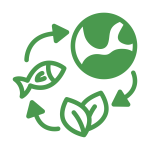
Ecosystems and Biodiversity
Ecosystems and biodiversity: Offer opportunities for your guests to learn about local ecosystems, such as forests, wetlands, and grasslands, and the biodiversity that they support. This may include learning about different plant and animal species, their roles in ecosystems, and the threats that they face from human activities. Research local animals or plants that may be under threat where you are.

Climate Change
We encourage you to be a climate change education leader. It is one of the most pressing environmental challenges facing this country. Sharing about the causes and impacts of climate change as well as solutions (e.g., renewable energy and energy efficiency) and adaptation actions you can take.
![]()
Outdoor Education
Outdoor education: Your work will offer unique experiential opportunities for your participants to learn about the environment first-hand, whether you are hiking, camping, canoeing, or visiting a local park or conservation area. Become a confident educator in your work. Outdoor time is also a great reducer of eco-anxiety (more later), so you play an important role in people’s wellbeing.

Environmental Action and Activism
Depending on your workplace or personal position, it is possible that environmental activism may enter into your sphere. This might mean making choices about the kind of employer you work for (choosing a company that places a priority on environmental wellbeing), personally participating in action projects on environmental issues that you are passionate about, or encouraging others to get involved. This may include activities such as organization-wide recycling programs, participating in environmental campaigns, or advocating for policy change through letter writing.
Climate Change and Outdoor Education or Recreation
Climate change will affect your outdoor education practice. It could be a threatened species like caribou impacting access to areas for mechanised activities or trailheads being inaccessible due to changing weather conditions (floods or lacking snow for winter recreation) when they have historically been open. When trail closures exist, it adds pressure to remaining open locations, causing for more crowded trails and the potential for increased trail erosion or damage.
As an Environmental Leader, making good choices that support your guests and the environment will be key. You may need to adapt your activity plans, including location, length, and difficulty in order to offer meaningful experiences. If this industry and your role in it are to continue sustainably, incorporating climate change and environmental education into your work is vital.
Case Study: The Abbot Pass Hut, Glacier National Park, Canada.“Climate change killed the Abbot Pass Hut. In 1922, Swiss mountain guides built the refuge in a lofty col in the Canadian Rockies, right on the B.C.-Alberta border. For 100 years it was one of the highest roofed accommodation in Canada. No longer. In recent years the frozen ground under the hut started thawing, compromising the integrity of the building. The Alpine Club of Canada, which managed the hut, closed it in 2018 and, after several studies, Parks Canada decided the only option was to scrap the shelter. In June contractors disassembled the Abbot Pass Hut rock by rock. “It’s emotional. It’s heartbreaking,” says Keith Haberl, the director of marketing and communications at the ACC. “Nobody wanted to see it go.” The demise of the hut is an example of the impacts climate change will have on recreation in British Columbia. Warmer summers, shorter winters, more intense precipitation, droughts and forest fire: the symptoms of global warming are influencing everything from biodiversity loss to how the public uses trails, the cost of building infrastructure to just getting to trailheads and campgrounds. We’re only just beginning to notice the effects, but before long they will be ubiquitous and experience altering.”[4] 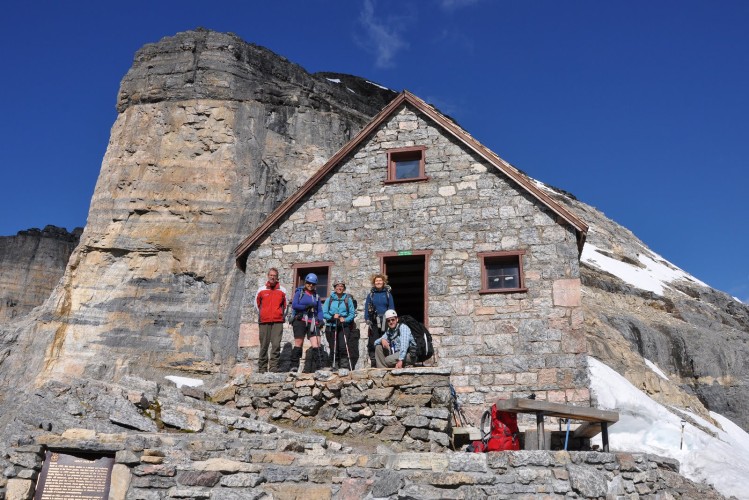 |
Social and Emotional Resilience
Most environmental education and outdoor guiding work necessitates a significant investment of social and emotional effort on the part of the practitioner. Most people who come to work in these fields feel strongly invested in the current wellbeing and future flourishing of the people, organisms, ecosystems, and/or outcomes they are working to promote and protect.
This deep investment means that individuals commit parts of their hearts, minds, and spirits to their focus area. When they then run up against others who do not share the same regard or encounter systems that diminish or destroy that which they strive to safeguard, they may feel the same frustration and pain as if their own person were being disregarded or harmed.
The reality of this intense social-emotional effort means practitioners need social-emotional support from those with whom they are in fellowship. In many cases, this fellowship arises in the space of communities that are working toward the same or similar goals. Mutual support among those with shared experience builds social-emotional resilience and allows the work to continue in the face of overwhelming odds. It is often in the spaces where the greatest social and emotional work occurs that the most is done to conquer seemingly insurmountable obstacles.
Trauma Aware as we Share
With the expanding impacts of climate disruption, how we approach communication becomes ever more important. Growing numbers of people have lived through an extreme event that may have left deep wounds in their psyche. The traumas that can result from these experiences are unique to every individual, and no two people experience trauma or react to trauma the same way.
By approaching all guiding communication with a trauma-aware lens, it is more likely that we will connect with our audiences rather than trigger a memory that may cause them unnecessary pain and drive them to denying the state of affairs and/or isolating themselves from all thoughts of climate disruption, its impacts, and, most significantly, its solutions.
What does it mean to be “trauma-aware”? It means that we are aware that trauma can happen, does happen, and exists throughout our work communities, and we therefore approach education and communication with psychologically informed skill. It allows us to approach climate change communication and education with a trauma-aware lens.
This means that we are sensitive to the fact that learning about new extreme events, hearing references to specific past events, and seeing images of impacted people and places may trigger memories along with psychological, physical, and cognitive reactions in people who have experience with trauma. This does not mean that we hide the truth. In the words of Joanna Macy, from her Personal Guidelines,

“This is a dark time, filled with suffering and uncertainty. Like living cells in a larger body, it is natural that we feel the trauma of our world. So don’t be afraid of the anguish you feel, or the anger or fear, because these responses arise from the depth of your caring and the truth of your interconnectedness with all beings.”
– Joanna Macy

Trauma-aware communication and education — on the most basic level — then means that we actively work to reduce the use of triggering words, phrases, and images in our materials and provide content and trigger warnings when needed.
There is much more to trauma-aware education and communication, some of which requires specialized training. But for starters, as you work through this section, reflect on how you can best connect with other people to communicate about climate change and support the work in your communities for climate resilience.
Let’s continue on by examining current trends, particularly concerning Eco-Anxiety and Climate Change.
- Willwerth J, Sheahan M, Chan N, Fant C, Martinich J, Kolian M. The effects of climate change on outdoor recreation participation in the United States: Projections for the 21st century. Weather Clim Soc. 2023 Jul 1;15(3):477-492. doi: 10.1175/wcas-d-22-0060.1. PMID: 37415774; PMCID: PMC10324584. ↵
- Harsimrenjit Singh, Mohammad Reza Najafi, Alex Cannon, (2022). Evaluation and joint projection of temperature and precipitation extremes across Canada based on hierarchical Bayesian modelling and large ensembles of regional climate simulations, Weather and Climate Extremes, Volume 36, https://doi.org/10.1016/j.wace.2022.100443. ↵
- Du Bray, M. V., Wutich, A., & Brewis, A. (2017). Hope and Worry: Gendered Emotional Geographies of Climate Change in Three Vulnerable US Communities. Weather, Climate, and Society, 9(2), 285-297. ↵
- Outdoor Recreation Council of BC https://www.orcbc.ca/blog/a-warming-planet-will-change-how-we-play August 28, 2022. Accessed Sept 1, 2023. ↵


